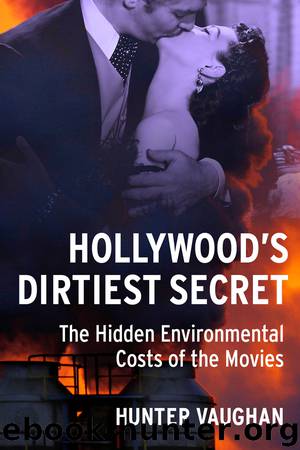Hollywood's Dirtiest Secret by Hunter Vaughan;

Author:Hunter Vaughan;
Language: eng
Format: epub
Publisher: Perseus Books, LLC
Figure 3.5 Referencing recent Hollywood blockbusters to contextualize itself as a CGI-effects action film, Twister’s (Jan de Bont, 1996) original poster features the tagline “The Dark Side of Nature”—confirming that nature is the film’s villain, human beings its heroes and victims. Source: Entertainment Pictures (Alamy stock photo).
In the introduction to his book on Twister, Davidson makes important connections among the ecodisaster genre, the problem of stylistic realism, and cinema’s greatly paradoxical responsibilities with respect to education and entertainment: “Every filmmaker who portrays a natural disaster … faces the same basic questions: How can this natural phenomenon, so alien to the ordinary filmgoer’s experience, be rendered realistically on the screen? How can the realistic look be balanced with the audience’s expectations? … In short, how can the silver screen do justice to the marvels of nature and, thereby, covertly educate moviegoers while overtly entertaining them?”61 The answer to this question seemingly lay in the recent advent of computer-generated imagery.
Toyed with in the late 1970s and 1980s, CGI had its major breakout in Steven Spielberg’s film Jurassic Park (1993), the success of which directly affected the development and production of Twister. Spielberg, who would receive a credit as executive producer of the latter film, ran Twister’s concept by the special-effects team at Industrial Light & Magic (ILM), the company started by George Lucas for creating the visual world of Star Wars and the effects haven that hatched the digitized dinosaurs of Jurassic Park. Doing what was essentially a digital test run, the ILM experts produced a simulated sample of what would be done for the majority of Twister, a process of live-action, analog-effect-driven filming, tightly orchestrated into a composition of preplanned digital postproduction work. Twister’s technological and commercial success would ultimately trailblaze the blockbuster digital era, leaving a winding path of adulation and technomanagerial romanticization. Indeed, following his questions, Davidson launches into a reification of the authenticity and potential of CGI, concluding that “any filmgoer can now undergo that unparalleled experience, thanks to the recent marriage of high-speed computers and Hollywood filmmakers.”62
However, to understand Twister only as a digital film would be a horrible oversight. Although the advance planning of CGI effects should presumably have made the analog shoot less taxing, this was not the case at all—in fact, the production was heavily laden with logistical difficulties and left a trail of material excess. Having started location filming in Oklahoma in April 1995, at the height of the rainy season, the shoot encountered weather issues in its first week. These obstacles, coupled with de Bont’s somewhat acerbic treatment of the crew, led to a turnover in the cinematographic team and the arrival of Jack Green, the production designer who would helm the film’s visual crafting, which began with the clairvoyant use of a “ ‘very fine-grain film’ to make it easy for digital effects artists to add realistic-looking computerized images of tornadoes.”63 ILM specialists were on set to make sure that the exposed footage would match the director’s planned CGI, which led to
Download
This site does not store any files on its server. We only index and link to content provided by other sites. Please contact the content providers to delete copyright contents if any and email us, we'll remove relevant links or contents immediately.
The Lonely City by Olivia Laing(4565)
Animal Frequency by Melissa Alvarez(4148)
All Creatures Great and Small by James Herriot(3980)
Walking by Henry David Thoreau(3681)
Exit West by Mohsin Hamid(3632)
Origin Story: A Big History of Everything by David Christian(3470)
COSMOS by Carl Sagan(3346)
How to Read Water: Clues and Patterns from Puddles to the Sea (Natural Navigation) by Tristan Gooley(3236)
The Inner Life of Animals by Peter Wohlleben(3099)
How to Do Nothing by Jenny Odell(3099)
Hedgerow by John Wright(3095)
How to Read Nature by Tristan Gooley(3073)
Project Animal Farm: An Accidental Journey into the Secret World of Farming and the Truth About Our Food by Sonia Faruqi(3013)
Origin Story by David Christian(2990)
Water by Ian Miller(2950)
A Forest Journey by John Perlin(2910)
The Plant Messiah by Carlos Magdalena(2745)
A Wilder Time by William E. Glassley(2686)
Forests: A Very Short Introduction by Jaboury Ghazoul(2668)
